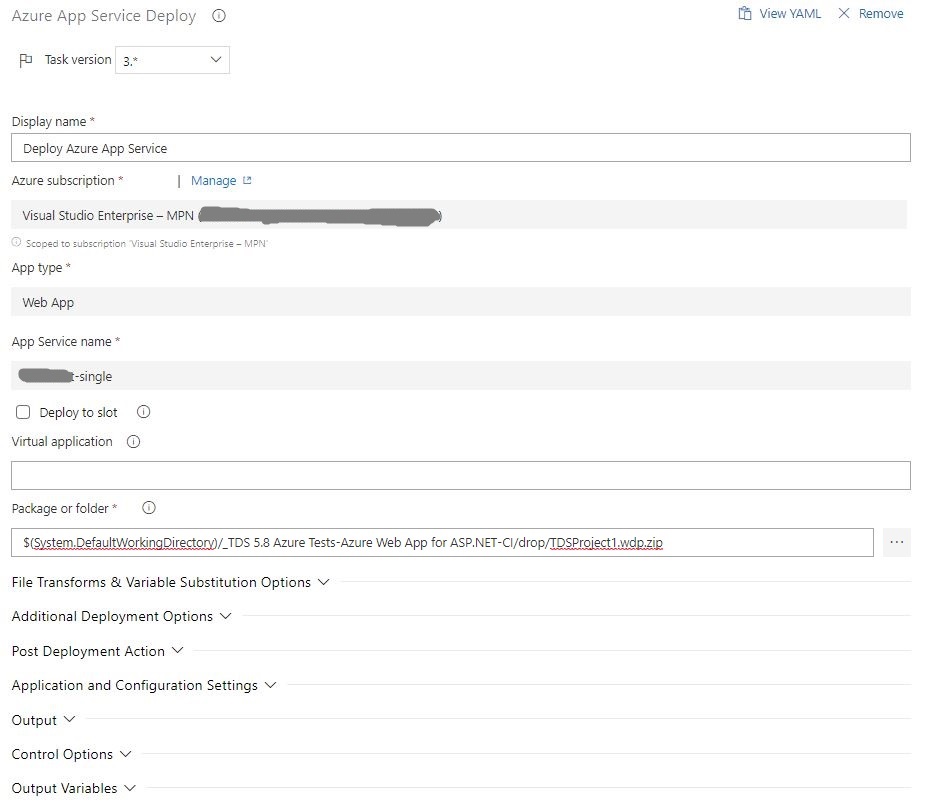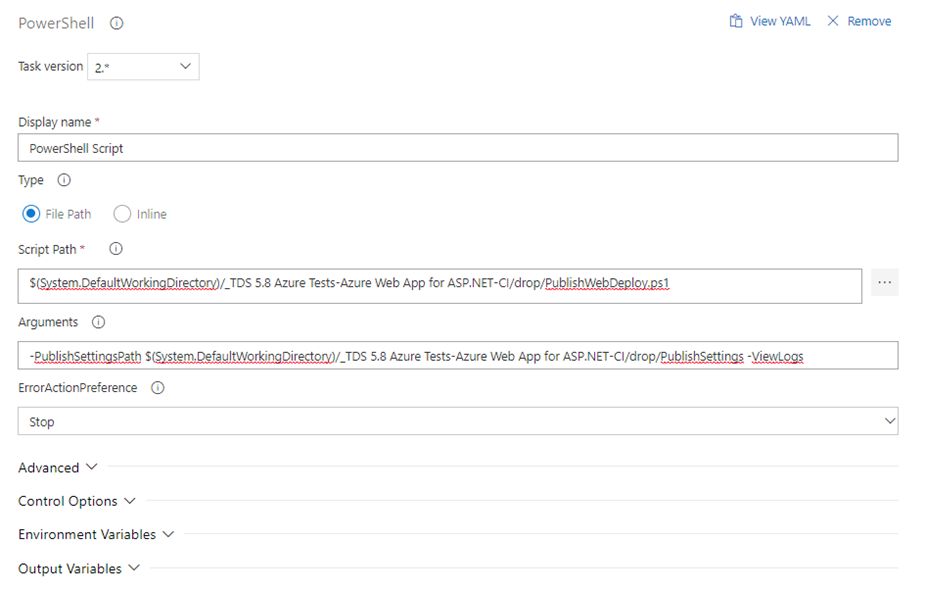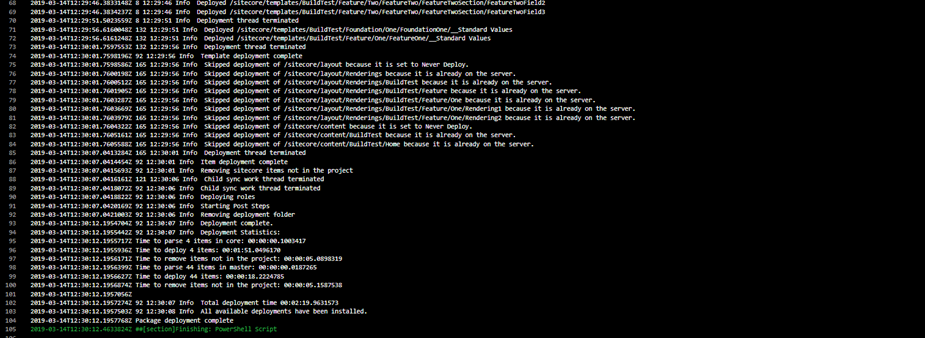Blog
Setting Up TDS 5.8 to Build to Azure Using Visual Studio Build and Pipelines: Configuring Azure DevOp's Release Pipeline
April 05, 2019 | Kliment Klimentov
In this part, we are configuring the settings in the Release pipeline to deploy our Web Deploy package. Although the deployment can also perform as part of the build, we prefer separate steps for build and deployment to reduce the chance of accidental deployments to production environments.
The Release pipeline takes the build artifacts from the Build pipeline and installs them on the Sitecore instances that have been configured in Azure. There are a couple of ways we can do this. We can use the generated PowerShell Script, or we can use some of the built-in settings in Azure DevOps. The PowerShell script can be modified to work within complex build processes, but the deployment can be accomplished even without it.
Deploy to Azure using the built-in Azure DevOps settings
Azure DevOps comes with a built-in App Service deploy task, taking the Web Deploy package from the Build pipeline and installs it in the selected Web App. Keep in mind, there are a couple of important configuration settings here. We need to add the Azure subscription where the Web App is located and select it under the Azure subscription tab. This fills out automatically as part of the settings, and you'll only need to select your subscription and App Service.

Deploy to Azure using the generated PowerShell Script
The second way of deploying the Web Deploy package to the Azure Web App is using the PowerShell script generated by TDS Classic. This can be useful in build servers where there's no native support for Azure Web deploy, or when the user wants full control and use their release script. The script also gives you an easy-to-read log containing the item names and location in the Sitecore tree of the items.
To use it, we need the Publish profile file, which can be added in source control and made available for the Release pipeline the same way we made available the PowerShell script and the Web Deploy package.
We also need to create a PowerShell Script task in our Release pipeline. In it, we specify the path to the PowerShell script, generated by TDS and the arguments, required for executing it. The arguments are the same as the ones we used for deploying from our development machine.

Both ways of deploying will give you status about the deployment and a log with all the details. The logs are formatted a bit differently, so consider this when choosing which method to use.

Summary
With TDS 5.8, we had the goal to simplify the deployment of the TDS project to Azure environments. Using Web Deploy packages, we were also able to reduce the deployment time while making the process more intuitive and visible for the developers.
The Release pipeline takes the build artifacts from the Build pipeline and installs them on the Sitecore instances that have been configured in Azure. There are a couple of ways we can do this. We can use the generated PowerShell Script, or we can use some of the built-in settings in Azure DevOps. The PowerShell script can be modified to work within complex build processes, but the deployment can be accomplished even without it.
Deploy to Azure using the built-in Azure DevOps settings
Azure DevOps comes with a built-in App Service deploy task, taking the Web Deploy package from the Build pipeline and installs it in the selected Web App. Keep in mind, there are a couple of important configuration settings here. We need to add the Azure subscription where the Web App is located and select it under the Azure subscription tab. This fills out automatically as part of the settings, and you'll only need to select your subscription and App Service.

Deploy to Azure using the generated PowerShell Script
The second way of deploying the Web Deploy package to the Azure Web App is using the PowerShell script generated by TDS Classic. This can be useful in build servers where there's no native support for Azure Web deploy, or when the user wants full control and use their release script. The script also gives you an easy-to-read log containing the item names and location in the Sitecore tree of the items.
To use it, we need the Publish profile file, which can be added in source control and made available for the Release pipeline the same way we made available the PowerShell script and the Web Deploy package.
We also need to create a PowerShell Script task in our Release pipeline. In it, we specify the path to the PowerShell script, generated by TDS and the arguments, required for executing it. The arguments are the same as the ones we used for deploying from our development machine.

Both ways of deploying will give you status about the deployment and a log with all the details. The logs are formatted a bit differently, so consider this when choosing which method to use.

Summary
With TDS 5.8, we had the goal to simplify the deployment of the TDS project to Azure environments. Using Web Deploy packages, we were also able to reduce the deployment time while making the process more intuitive and visible for the developers.
Missed Part Two? Click here to read how to configure Azure DevOp's Build Pipeline.
Need to start from the beginning? Click here to read how to set everything up locally.
Try out TDS 5.8 with a free 30-day trial or purchase it today!
Tags
Related Blog Posts
- TDS Classic goes to Australia
- Hedgehog Solution Architect, Sean Holmesby will be presenting at SUGCON ANZ. He gave insight on his topic and more.
- TDS Classic to Support Rainbow
- <p>At SUGCON London, Sitecore announced they would be switching over their default serialization format to Rainbow, a YAML-based format for Sitecore serialization in Sitecore version 9.2., and TDS Classic is ready to support it. </p> <div> </div>
- What is New in TDS Classic 5.8?
- We go over the new features in TDS Classic 5.8 that can help significantly improve your experience.
- Setting Up TDS 5.8 to Build to Azure Using Visual Studio Build and Pipelines: Configuring Azure DevOp's Build Pipeline
- In this part, we'll configure only the steps in the Build Pipeline, and publish the build drop (a Web Deploy package and a PowerShell script) to the Release pipeline.
- Setting Up TDS 5.8 to Build to Azure Using Visual Studio Build and Pipelines: Local Set Up
- By using TDS 5.8 and Web Deploy packages, we'll show you how to create a fully automated build and deployment process from your workstation to source control and into your Azure environment.
- A Look Back at TDS Classic
- TDS Classic has been helping Sitecore developers for 10 years. We spoke with Sitecore Solution Architect and Chief Product Scientist, Charlie Turano to reflect back on the making TDS Classic.
- Hedgehog Announces the Release of TDS Classic 5.8
- Hedgehog announced the release of TDS Classic 5.8. The newest update now supports Azure and Visual Studio 2019.
- TDS Classic Licensing FAQ
- Answers to a number of frequently asked questions regarding the licensing of TDS Classic.
- The Benefits of Renewing a TDS Classic License
- New features and early access to the latest and greatest in the Essential Collection are just a few reasons to keep your TDS Classic license active.
- Guide to Sitecore Packaging
- Development of features and components requires a set of Sitecore items to be packaged - things like renderings and templates. With TDS Classic, Sitecore developers can automate the packaging process.
- TDS Classic as a Tool for Technical Audits
- TDS Classic provides Project Report generation for Sitecore items, which can be very helpful with technical audits
- TDS Classic: Content File Sync
- Content File Sync is a fantastic time saver for any Sitecore developer.
- TDS Classic How-To: Perform Unattended Installation of TDS Classic for Visual Studio 2017
- The TDS Classic version for Visual Studio 2017 is installed a bit differently than previous versions; the process is separated in two parts and performed by two different installers.
- TDS Classic 5.7 - Lightning Deploy
- Lightning Deploy Mode can be used to enable Lightning Mode for all deployments that utilize the TDS Sitecore Connector in their configuration, improving their speed and efficiency.
- TDS Classic 5.7 - Lightning Sync
- Lightning Sync allows both sync and quick push operations to use TDS Classic 5.7's new Lightning Mode feature
- TDS Classic 5.7 - Solution Wide Sync
- A simple new feature in TDS Classic 5.7, Solution Wide Sync makes a big difference when working with many TDS Classic projects in a solution.
- TDS Classic 5.7 - Lightning Mode
- Lightning Mode helps to improve the speed and efficiency of both deploy and sync operations. This enhancement is achieved by modifying how item comparisons are performed.
- TDS Classic Best Practices: NuGet Build Components and TDS Classic .user configs
- There are certain systems and processes that you can put in place to make a TDS Classic project run more smoothly. We're highlighting the best practices that our team recommends for getting the most out of TDS Classic.
- TDS Classic Best Practices: Bundle Packages, Delta Builds and Delta Packages
- Following TDS Classic best practices, like using Delta Builds and Delta Packages, can make the entire development experience run much more smoothly.
- TDS Classic Best Practices: Validators and the Sitecore Package Deployer
- TDS Classic can be used in many ways, but the goal is always the same: make development (and developers lives) easier. Whether it's using the Sitecore Package Deployer or using validators, following best practices can make your entire experience run much more smoothly.
- Troubleshoot and Prevent Failed TDS Classic Project Builds
- When building an .update package with TDS Classic, the build might fail with no additional information. From increasing log verbosity to using validators, there are ways to minimize or prevent this type of error.
- TDS Classic How-To: Disable Automatic Code Generation
- Code Generation is automatically triggered after every change in the TDS Project tree. If a project contains many items, users can disable this feature for their convenience.
- TDS Classic Sitecore Deploy Folder
- Sitecore Deploy Folder is a setting, located in the build tab of the TDS Classic Project's Properties page, and used to tell TDS Classic where the webroot is located.<br>
- TDS Classic Builds on Jenkins Build Server with NuGet Packages
- Our simple scenario includes 2 developers using TDS Classic and checking-in changes to source control. The Jenkins build server takes the changes and performs the build, and then deploys the created package to two Sitecore environments.
- Features to Improve Sitecore Development: TDS Classic Strikes Back
- Each and every feature in TDS Classic is aimed at helping developers. Whether the feature is out front or running quietly in the background the goal is always the same: make the development experience better.
- TDS Classic Features to Improve Sitecore Development
- Each version of TDS Classic comes with the same goal: to make Sitecore development and, by extension, developers, lives easier. Every feature in our products is aimed at making the process better - some of these features aren't quite as well-known as others, but they all help smooth and improve the development experience.
- Deployment Properties and the Deployment Property Manager
- When working with TDS Classic, you will eventually need to deploy your items to a Sitecore instance and you might not want the default behavior of every item in your TDS project deploying every time. This is where the TDS Sitecore Deployment Property Manager comes in!
- TDS Classic How-To: Use the HedgehogDevelopment.TDS NuGet Package
- The HedgehogDevelopment.TDS NuGet Package allows you to build TDS projects, without the need of installed TDS on the build server machine.
- TDS Classic 5.6 Feature Spotlight - Prevent Deployment of Incorrect Assemblies
- This feature, new to TDS Classic 5.6, will prevent a solution from deploying unless all assemblies (except the excluded assemblies we allow you to specify) match what exists in your webroot.
- TDS 5.6 Feature Spotlight - Project Item Report
- This feature, new to TDS Classic 5.6, allows you to create a report of all items in the TDS Classic project.
- TDS How To: Install the TDS Connector for Rocks 2.0
- Manually install the TDS connector for Sitecore Rocks 2.0
- Create TDS Classic Custom Post Deploy Step
- Team Development for Sitecore Classic version 5.5 allows developers to add post deployment steps to to their deployments and update packages. TDS Classic has used post deployment steps internally to perform a number of useful functions. Many of the developers using TDS Classic have requested the ability to add their own post deploy functionality. With the release of TDS Classic 5.5 in early 2016, this functionality is now available.
